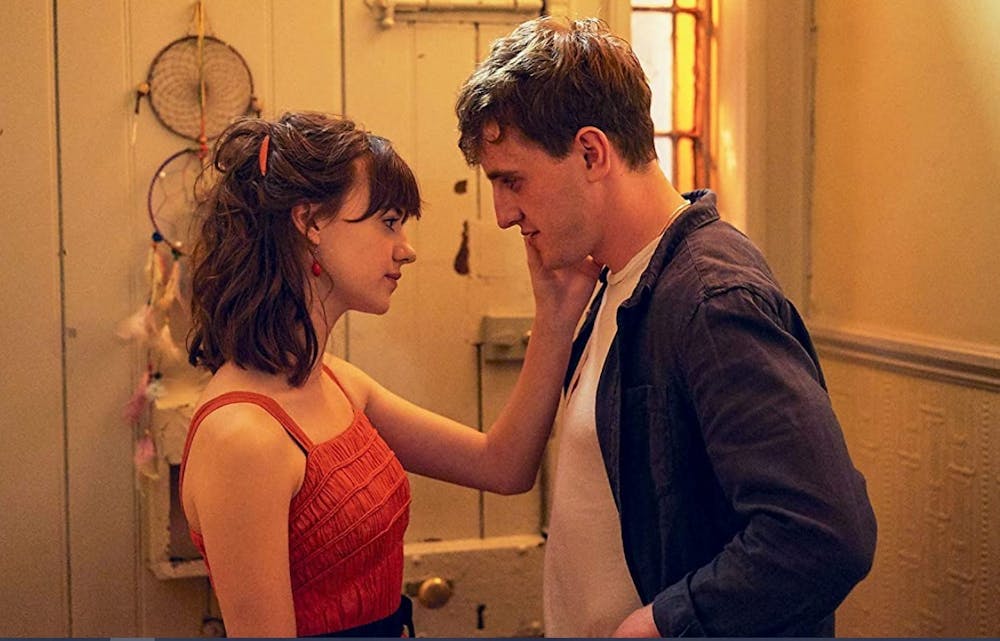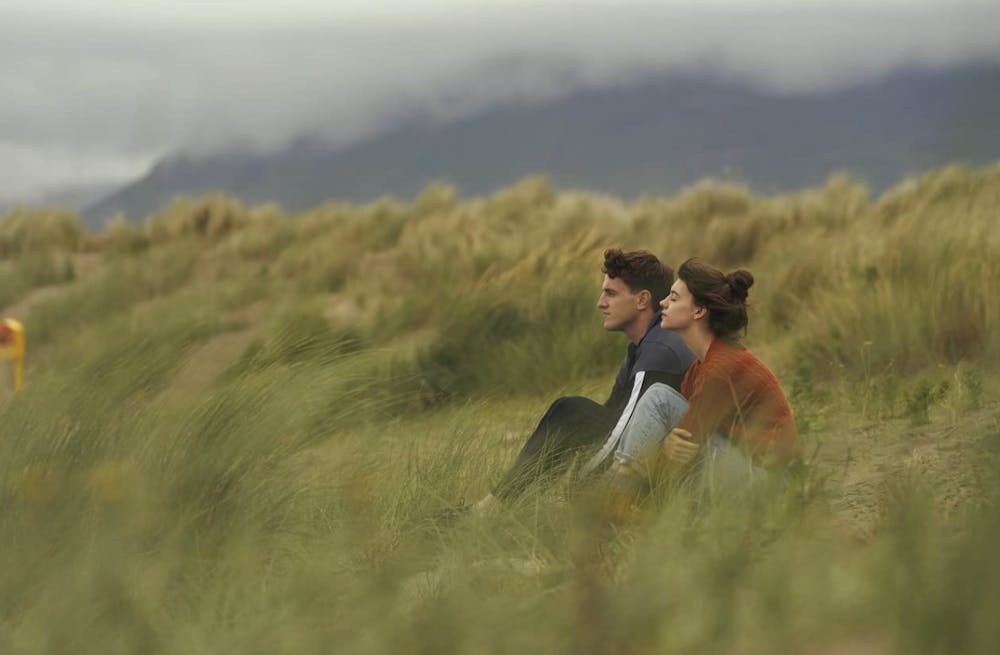Note: As the editing in this article does not adhere to the Byte or AP style guide, our editors found naming the characters in Sally Rooney’s novel, Normal People, by their first names on subsequent reference would adhere better to the novel’s and audience’s understanding of the storyline.
Over this past summer I found myself hankering for a good book. After searching through multiple “Top 10” lists of new cutting-edge novels, my mother suggested Sally Rooney’s Normal People. I heeded her advice and picked up a copy at the nearest bookstore. After the first 10 pages I had lost myself in the world of Rooney, a young Irish writer making waves in pop literature. Rooney gained prominence with the release of her second book, Normal People.
In April 2021, the novel was adapted into a Hulu miniseries written by Sally Rooney, Alice Birch, and Mark O’Rowe. The story takes place at the start of the 2011 economic collapse in a small town on the coast of Ireland, Carricklea in County Sligo. Our lead characters, Connell Waldron, played by Paul Mescal, and Marianne Sheridan, played by Daisy Edgar-Jones, begin a clandestine relationship during high school, which progresses into an on-again, off-again relationship. Despite the intimate nature of their relationship, Connell refuses to acknowledge Marianne at school because of her aloof and odd reputation. Connell’s shame and guilt builds up which pushes him to unknowingly bring about a pause in their relationship when he asks another girl to the upcoming dance Marianne helped plan. However, at university the dynamics of the relationship change. Both Connell and Marianne move to Dublin to study at Trinity. At university, Marianne is socially accepted by her peers, while Connell is keenly aware of his lower-class status. He feels insecure and uncomfortable in social environments, and as a result has many acquaintances but no real friends, save for Marianne. The two characters connect on a level of genuine care and affection that is often tested by external forces. Throughout the story, viewers watch the characters struggle to come together, oftentimes falling apart and then coming together again, with neither able to communicate well enough to keep the relationship alive.
Marianne and Connell's relationship resonated with viewers because of its willingness to stray from broad generalizations and dig to the core of these commonly recognized sentiments. The plot includes a few popular tropes common in young adult romances such as clandestine relationships, different backgrounds, second chance romance, etc. These tropes often manage to diminish the importance and validity of relationships that end up shaping how we interact with love in our adult lives. However, this is not the case with Normal People. Normal People manages to evade the shallowness of these stereotypes, instead finding depth in an uncommonly truthful perspective on young love and life.

Photo by IMDb
An Authentic 21st Century Woman
Marianne is a nuanced look into the unique life of a 21st-century woman. She is flawed and imperfect, while remaining determinedly truthful to what matters most. As a 21-year-old woman, I have seen myself in the unique honesty of Marianne. Over my years of consuming pop culture media, I have watched many female characters in their 20s fall prey to the “manic pixie dream girl” stereotype, but Rooney opts for authenticity in the quirks and difficulties of Marianne’s life. Marianne was brought up in an abusive household. Rooney never passes judgement on Marianne, even when the consequence of her familial relationship impacts her other, often romantic, relationships. Normal People chooses the path less traveled, revealing the complexity of physiological states and experiences that influence future relationships. Rooney’s care when writing Marianne is obvious to an observer. She said this about writing Marianne:
“When I’m writing about Marianne, I am not trying to write about women, and stuff women go through. I’m not trying to write about her as an example of womanhood or young Irish womanhood. That doesn’t interest me at all. What interests me is how this person, in this particular set of relationships: within her family, within her school, and so on, navigates those things with a sensitivity to what is irreducibly individual about her. That can’t be described by the forces [of womanhood] but rather how those forces shape and condition her responses to things.”
Rooney wildly succeeds at this, sketching a portrait of Marianne that is honest and alive. I found Marianne to be an authentic, nuanced character and her struggle to make sound life choices relatable and real, sometimes frustratingly so. She doubts herself and struggles with self-hatred brought about by her surrounding relationships. These elements play into her relationship with Connell, who struggles with self-worth and mental health.

Photo by IMDb
An Honest Look into Mental Health and Masculinity
Connell is a young man who tries desperately hard to make everyone happy, often resulting in the neglect of his personal happiness. Near the end of the story, Connell goes to therapy at the suggestion of his roommate Nial. The scene is a culmination of Connell’s feelings of loneliness and isolation. In high school, he was well-liked but didn’t connect to his friends on a deep level. At university, he struggles, feeling like an outsider in a place he believed would understand and accept him. I found this scene heartbreaking. Paul Mescal executes this moment with gut-wrenching vulnerability as Connell desperately chokes down his tears in an attempt at explaining his circumstance to the therapist:
“I don’t really click with people. I left Carricklea thinking I could have a different life. But I hate it here and I can never go back because old friendships are gone, and Rob is gone, and I can't see him again. And I can't get that life back. “
In the final moments of the scene, he apologizes to his therapist for breaking down in a way that expresses broken self-confidence and absolute frustration with life. Despite his hardships, Connell maintains an emotional honesty and vulnerability that draws people to him. Connell’s shy, and sensitive masculinity is uncommon in today’s pop culture. He is kind, well-meaning, and treats people with an unusual genuineness. The scenes between Connell and his mother, played by Sarah Greene, illustrates a mother-son relationship with trust and care that I have seldom observed represented in pop culture. Connell is a refreshing portrayal of masculinity, unburdened by the stereotypes of modern society.
Normalcy in Intimacy
The intimate scenes between Connell and Marianne are frequent throughout the series but manage to escape the stereotypical route of the genre by including intimacy as a means to deepen the viewers understanding of the characters and their relationship. The intimacy is not on the screen because “sex sells," but rather to push the plot and characters forward. These scenes dive into the truth of Marianne and Connell’s relationship, as expressed by Daisy Edgar-Jones in a recent Variety interview:
“If you’re trying to tell the truth about a relationship, you have to also include the truth of
what that means in terms of intimacy.”
The intimacy is very realistic, showing both characters' bodies equally on screen, rather than falling prey to depicting soley female nudity. It portrays parts of sex that are ignored in popular media, basking in its normalcy. The scenes are shot with a shallow depth of field, allowing the camera to pick up small details that would only be observed by the human eye. It pushes the viewer into the story, bringing them close and revealing the humanity and normality of intimacy. Rooney said this about normalcy:
“What I really love to read about and to write about are experiences that are in fact
completely benail, but that don’t necessarily conform to our narratives about what
normality is. So, like experiences that maybe feel weird while they’re happening, but are
in fact, utterly run of the mill.”
Ita O'Brien was the intimacy coordinator on set, working closely with the cast and crew to create a healthy environment for the actors. The comfort of the cast is easily observed through effortless and natural chemistry, allowing Connell and Marianne’s intimate moments to feel normal within the high stakes and vulnerability of the situation.

Photo by IMDb
Coming of Age within a Relationship
The relationship between the two characters carries a normalcy that resonates in a very intense and special way. Both Marianne and Connell share high levels of intellect that are reflected in their relationship. They avoid the tropes of 20-something relationships by engaging in meaningful and honest conversations about life, mental health, and human connection. The story shows these two characters coming back into each other's lives over and over. Each time they return to each other they are changed. Sometimes they reunite as friends and other times as lovers. In this sense, the story burrows to the core of the popular trope “will they or won't they," instead opting for an inconclusive ending that brings real care and consideration to the examination of Connell and Marianne’s past. The end reveals two characters who are no longer the kids they were in high school, but rather young adults who have changed each other throughout the course of their relationship. From one another they have learned how to be loved and how to love. It is a relationship that may never work but is invaluable to the course of our main characters’ lives. Rooney has set this love story apart by calling attention to the validity and sincerity of these character defining relationships that often accompany early adulthood. She treats her characters with respect, acknowledging the intelligence and malleability of young love. As a consumer of popular media, I have observed time and time again, love stories depicting young love as naive and shallow. The effect of this is always the same: unintentionally discrediting the importance and intelligence of young people in love. Rooney never overlooks the importance of these characters' love for one another and, because of this, she creates one of the most relatable and honest interpretations of a generation defining love story.
Featured Image from IMDb
Sources: IMDb, IMDb, IMDb, YouTube, YouTube, IMDb, Variety, YouTube, Ita O'Brien





The Daily News welcomes thoughtful discussion on all of our stories, but please keep comments civil and on-topic. Read our full guidelines here.